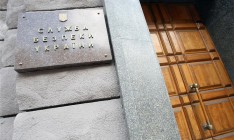Economy
debtsThe government wants to monitor holders of T-bills

The Anti-Corruption Agency of Ukraine has recommended the Cabinet of Ministers to hold an inquiry into the holders of government securities and sources of funds used for purchasing them. A source in the Cabinet of Ministers told Capital that the proposal has been made in a memo sent to Premier Arseniy Yatsenyuk. The authors of the document specify that the issue of internal government bonds could have been used for legalization of shadow funds thus inflicting damage to the economy.
According to the document that Capital possesses, the agency has most questions to treasury bills denominated in US dollars maturing this year. “The main method of masking front men among bona fide holders of internal government bonds was an increase in the number of ordinary bondholders. […] Employees of the offices of the state-owned Oschadny Bank were forced to purchase certificates of the T-bills at the price of US $500 under the threat of being fired,” reads the memo.
In order to uncover “mala fide” investors, the officials propose to hold registration of holders of bonds maturing in 2014 on the website of the NBU and in the offices of state-owned banks. In addition to standard information, it is proposed to conduct a mandatory survey of the circumstances under which the securities were purchased and also confirmation of the legal source of funds for their purchase. Holders of bonds of large amounts will be additionally inspected for possible use of them as front men.
Referring to the data of the Ministry of Finance, the Anti-Corruption Agency notes that as of May 30, the volume of internal government bonds in circulation amounted to UAH 289.9 bn. Of them, UAH 177.2 bn is owned by the NBU, UAH 86.4 bn – by other banks, UAH 10.1 bn – by other entities and UAH 16.1 bn – by non-residents. The last two groups are in the risk zone, notes the agency.
Analysts asked by Capital view recommendations of the agency with skepticism. The NBU is the depository of internal government bonds and it sees all holders, said Head of Local Fixed Income Department at Concorde Capital Yuriy Tovstenko.
In addition, the Financial Monitoring Department of Trading inspects the legality of the funds at the stage of closing a deal and the tax authorities are empowered to request data for inspections from the NBU, the depository and traders.
“That is why I see no problem or necessity in registration of holders of internal government bonds. It is much harder to trace the end holders of treasury bills (certified debt securities, payable to bearer), but the mechanism of registration of end holders is not clear judging from this document,” says Tovstenko.
In addition to that, the volumes of T-bills seem ridiculous compared to the volumes of government bonds. In 2012-2013, the Ministry of Finance issued T-bills to the tune of US $200 mn (UAH 2.8 bn of UAH 289.9 bn of government bonds in circulation). The first series envisaged a yield of 9.2% and the second – 8%. The main purpose of the issue of these securities was actually pulling the funds of citizens out of the shadow and into the country’s economy.
According to the calculations of the Ministry of Finance, the population last year had around US $70 bn. Along with that the government had hoped to start the process of de-dollarization. The yield was to attract a part of foreign currency funds of Ukrainians by offering them an interest rate that would be competitive with the rates for currency deposits in banks.
Changing the conditions of circulation, including through disclosing information about the holders and source of funds, can undermine people’s trust in government securities, to say the least. Unlike government bonds, the people could directly purchase T-bills. Earlier, the Ministry of Finance announced plans of issuing T-bills to average citizens to the tune of UAH 2.6 bn in 2014. It was planned that the currency treasury notes would be issued in two series in the amount of US $100 mn each and two series of hryvnia treasury notes in the amount of US $500 mn.







 of the agreement of syndication with Financial Times Limited are strictly prohibited. Use of materials which refers to France-Presse, Reuters, Interfax-Ukraine, Ukrainian News, UNIAN agencies is strictly prohibited. Materials marked
of the agreement of syndication with Financial Times Limited are strictly prohibited. Use of materials which refers to France-Presse, Reuters, Interfax-Ukraine, Ukrainian News, UNIAN agencies is strictly prohibited. Materials marked  are published as advertisements.
are published as advertisements.